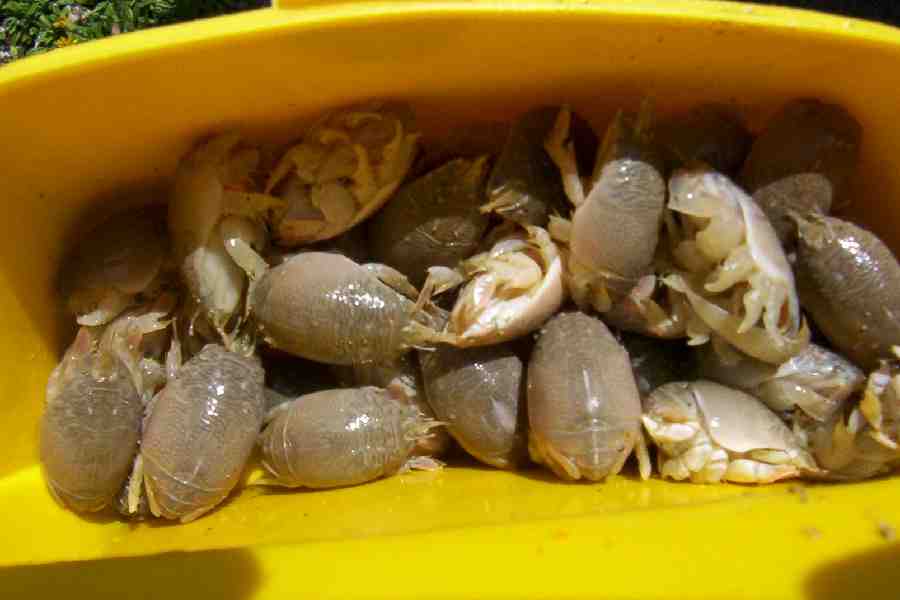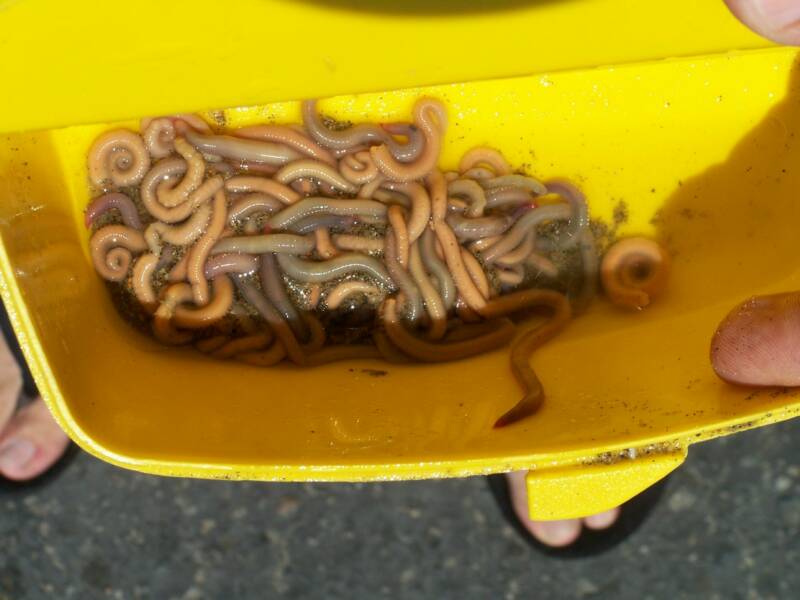Candy Bait For Corbina
When spring rolls around corbina have been hole-up in bays, harbors and estuaries. As the water warms they know it’s time to leave these safe confines and make their way to the beach. As they spread out along the shore corbina search for the fine odor of fertile sand crabs and gorge themselves. Weeks, then months go by and all they eat are crabs—wonderful crabs. But like any good diet even the best foods get a bit dull and that’s where ghost shrimp replace prime crab rib with lobster.
 Ghost shrimp have always been known as the “candy bait” of the surf. Available in stores for decades shrimp are now flown in from half-way across the world or caught at your local estuary. Although very few stores now carry ghosties you can still find them with a little patience and perseverance near harbors, bays and estuaries.
Ghost shrimp have always been known as the “candy bait” of the surf. Available in stores for decades shrimp are now flown in from half-way across the world or caught at your local estuary. Although very few stores now carry ghosties you can still find them with a little patience and perseverance near harbors, bays and estuaries.
Ghost shrimp can be found in many places along the Southern California and Northern Baja coast. Adult shrimp grow to about 4.5” and males tend to have one claw that is considerably larger than the other. Most shrimp are from clear or even white (as with a grass shrimp) to orange and brown in color.
Shrimp enjoy living in sandy and muddy intertidal zones, bays and estuaries. They call home inside burrows, which they share with other fish and invertebrates. Their main meals consist of plankton and “detritus,” which consists of small pieces of organic plant and animal waste.
The best place to find shrimp (in addition to a few choice tackle stores) is along the shore of bays that contain exposed sand and mud flats. Shrimp find it easiest to live in flats that are a combination of sand and mud–Most notably, an area where a 6” layer of mud has been deposited on top of a sand bar. Low tide rising to a high tide seems to offer one of the best times to trap shrimp.
Look for shrimp under holes you find on the mud flats. I like to try to find the holes that have a recent deposit of fresh sand around their opening. Shrimp can be dug by hand, or most effectively, by using a hand suction pump. You can purchase stainless steel pumps manufactured by Alvey, Australia, or you can build one yourself using parts purchased at your local hardware store.
 Shrimp are best kept in the refrigerator inside a plastic container with or without salt water. Look for them to live about 3 days without water and about a week with it. I use a five-gallon plastic aquarium to keep my shrimp fresh. Water can be kept cold by placing one or two frozen water bottles inside a five-gallon aquarium or by placing the aquarium itself in the refrigerator.
Shrimp are best kept in the refrigerator inside a plastic container with or without salt water. Look for them to live about 3 days without water and about a week with it. I use a five-gallon plastic aquarium to keep my shrimp fresh. Water can be kept cold by placing one or two frozen water bottles inside a five-gallon aquarium or by placing the aquarium itself in the refrigerator.
Rigging your surf fishing set up for a ghost shrimp is easy. I like to use the Carolina rig tied to 6lb monofilament fished on an 8’ rod matched to a 2500 series-spinning reel. The Carolina rig is nothing more than a sliding sinker, a bead, a swivel, 18”-36” of 6lb fluorocarbon leader and a super sharp hook. I like to use a #4 kahle or #4 sproat hook for shrimp. You can get a good look at the rig by visiting the “rigging” page on my site at fishthesurf.com.
Ghost shrimp are fragile and can be tricky to hook. The biggest reason fishermen don’t use this bait is because it commonly flies off the hook while casting. Here are a few tips to help you securely hook the shrimp so they can be easily delivered right to where the fish are.
Use a long shank worm hook or Kahle hook for shrimp. Turn the bait on its back and insert the hook into the underside of the tail. Carefully, feed the hook up the center of its body. Exit the “business” end of the hook, to just above the barb, just below the shrimp’s head, (through the carapace between it’s legs). This method of hooking does two things: First, it allows the bait to lie flat on your hook (When the bait is flat it doesn’t spin and looks natural). Second, this helps to secure the bait to your hook and reduce the number of times the bait flies off during a cast.
When fishing for corbina keep in mind that they will be feeding very close to shore. I find the best beach to fish is one that is sloping and goes from shallow to deep with a slight incline. The best tide to fish for corbina is from low tide, up until high tide. This way corbina ride each successive wave farther up the beach as it is covered by water in search of food.
I fish shrimp very close to shore. Not only because you can’t cast them a mile but also because the fish are feeding in close. As a result, I generally use a longer 4 or 6lb fluorocarbon leader (24”+) and a very light egg sinker. Split shot or a sliding egg sinker up to ½ ounce (at the very most) is just enough to keep your bait in the zone.
After I cast out slowly retrieve your bait, always keeping tight to your sinker. If you’ve found the right place to fish you have just cast over the inshore trough. As you reel back toward shore your sinker will fall and “catch” the side of the trough. STOP HERE. This way your sinker is lodged in the shore side of the trough and your bait (on that 24”+ leader) is waving back and forth across the trough like a soldier on leave! That’s a corbina super highway with a lobster thrashing in melted butter right in the middle of the road!
 Don’t ever reel your bait in until you see the egg sinker hit the sand. So many big ones have been caught in just inches of water and you don’t want to be the one who sees their corbina shrug it shoulders, wave a fin and swim away.
Don’t ever reel your bait in until you see the egg sinker hit the sand. So many big ones have been caught in just inches of water and you don’t want to be the one who sees their corbina shrug it shoulders, wave a fin and swim away.







